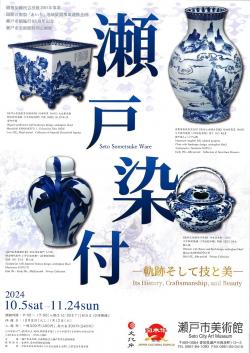![]()
![]()
![]()
A Project Commemorating the Bicentennial of Kato Tamikichi’s Death Aichi Triennale Local Development Collaborative Project The 95th Anniversary of the Municipalisation of Seto Seto City Art Museum Special Exhibition Seto Sometsuke Ware - Its History, Craftsmanship, and Beauty -
Porcelain production in Seto began during the late Edo period (1603-1868), with the predominant type being Sometsuke porcelain decorated with blue pigments. However, early Seto Sometsuke was of lower quality compared to Kyushu Hizen ware, which began production in the early 17th century. To address this quality gap, Kato Tamikichi, the creator of Seto porcelain, travelled to Kyushu to learn porcelain production techniques. After completing his three-year apprenticeship, Tamikichi taught the techniques he had learned in Kyushu to Seto. As a result, the quality of Seto’s Sometsuke porcelain greatly improved, and it developed into a major industry of the Owari clan.
During the Meiji period (1868-1912), the Owari clan’s protection and control were lifted, beginning a period of free competition. Seto potters eagerly showcased their pottery at the World Expositions in Europe and the USA. Their Seto Sometsuke ware, renowned for its intricate craftsmanship and delicate designs, garnered high praise and acclaim. This influenced Japonisme and Art Nouveau, which later gained popularity in Europe and the USA and provided an opportunity to expand exports. As a result, Seto Sometsuke made significant strides, and many outstanding works were produced. The industry also modernised its technology, and Seto Sometsuke has continued to evolve to the present day.
This exhibition brings together pieces from the early days of Seto Sometsuke during the late Edo period, as well as works created for the Owari clan, pieces exported overseas during the Meiji period and later returned home and works by artisans from the Showa period who produced intangible cultural properties. In addition, there will be a special display of bonsai planters used by the imperial family. This year marks the bicentenary of the death of the porcelain master Kato Tamikichi, and we hope that visitors will enjoy viewing the numerous masterpieces while tracing Seto Sometsuke’s trajectory, reaffirming its exquisite craftsmanship and beauty that has captivated the world.


※Closed:10/8(tue), 11/12(tue)
※Free for junior high school students and younger, those 65 and older, pregnant women,
and those with a disability certificate(Mirairo ID accepted) .
※Admissison fees in parentheses apply for groups of 20 or more
Lecturer: Mr. Takashi OKAMOTO, Chief Curator of Housed in the Museum of the Imperial Collections, Sannomaru Shozokan
Mr. Kazunobu SATO, Director of Aichi Prefectural Ceramic Museum
Host:Humitaka HATTORI,Fellow of Seto City Art Museum
Date & Time: Satueday, Nobember 23, 2024, 1:30 p.m.(about 1 hour)
Laguage: Japanese only
Place: Conference room 31, Cultural Exchange Hall, Culture Center
Capacity: 80 participants
※Free admission, no reservation required
Date & Time: Satueday, Nobember 23, 2024, 1:30 p.m.(about 1 hour)
Laguage: Japanese only
Place: Seto City Museum galleries
Capacity: 10 participants
※Free admission(admission fee required), no reservation required
Adress:113-3 Nishiibara, Seto Aichi